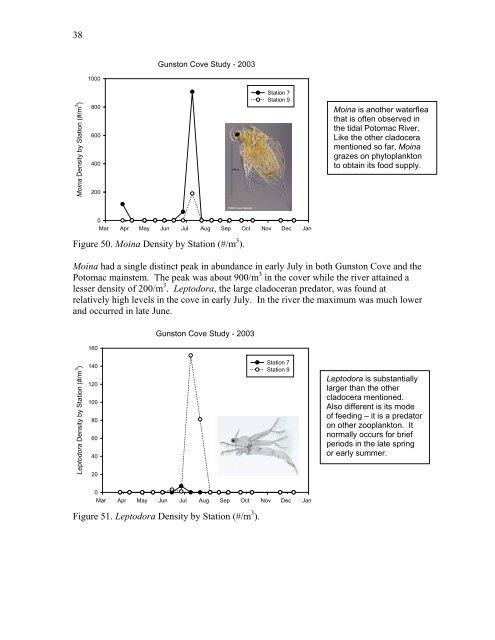NEW: Annual Report - George Mason University
NEW: Annual Report - George Mason University
NEW: Annual Report - George Mason University
You also want an ePaper? Increase the reach of your titles
YUMPU automatically turns print PDFs into web optimized ePapers that Google loves.
38<br />
Moina Density by Station (#/m 3 )<br />
1000<br />
800<br />
600<br />
400<br />
200<br />
Gunston Cove Study - 2003<br />
Station 7<br />
Station 9<br />
0<br />
Mar Apr May Jun Jul Aug Sep Oct Nov Dec Jan<br />
Figure 50. Moina Density by Station (#/m 3 ).<br />
Moina is another waterflea<br />
that is often observed in<br />
the tidal Potomac River.<br />
Like the other cladocera<br />
mentioned so far, Moina<br />
grazes on phytoplankton<br />
to obtain its food supply.<br />
Moina had a single distinct peak in abundance in early July in both Gunston Cove and the<br />
Potomac mainstem. The peak was about 900/m 3 in the cover while the river attained a<br />
lesser density of 200/m 3 . Leptodora, the large cladoceran predator, was found at<br />
relatively high levels in the cove in early July. In the river the maximum was much lower<br />
and occurred in late June.<br />
Leptodora Density by Station (#/m 3 )<br />
160<br />
140<br />
120<br />
100<br />
80<br />
60<br />
40<br />
20<br />
Gunston Cove Study - 2003<br />
Station 7<br />
Station 9<br />
0<br />
Mar Apr May Jun Jul Aug Sep Oct Nov Dec Jan<br />
Figure 51. Leptodora Density by Station (#/m 3 ).<br />
Leptodora is substantially<br />
larger than the other<br />
cladocera mentioned.<br />
Also different is its mode<br />
of feeding – it is a predator<br />
on other zooplankton. It<br />
normally occurs for brief<br />
periods in the late spring<br />
or early summer.
















